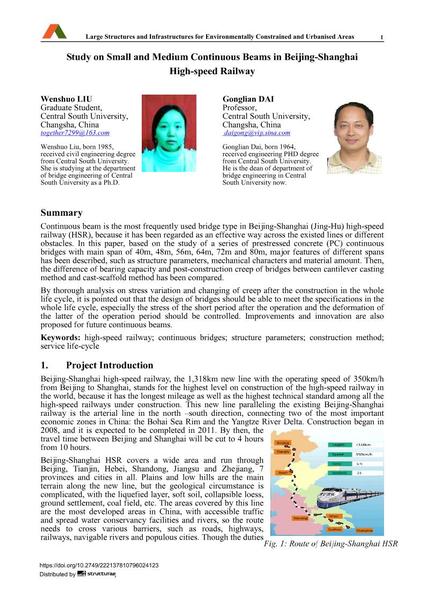Study on Small and Medium Continuous Beams in Beijing-Shanghai High-speed Railway

|
|
|||||||||||
Bibliographic Details
| Author(s): |
Wenshuo Liu
Gonglian Dai |
||||
|---|---|---|---|---|---|
| Medium: | conference paper | ||||
| Language(s): | English | ||||
| Conference: | IABSE Symposium: Large Structures and Infrastructures for Environmentally Constrained and Urbanised Areas, Venice, Italy, 22-24 September 2010 | ||||
| Published in: | IABSE Symposium Venice 2010 | ||||
|
|||||
| Page(s): | 166-167 | ||||
| Total no. of pages: | 7 | ||||
| Year: | 2010 | ||||
| DOI: | 10.2749/222137810796024123 | ||||
| Abstract: |
Continuous beam is the most frequently used bridge type in Beijing-Shanghai (Jing-Hu) high-speed railway (HSR), because it has been regarded as an effective way across the existed lines or different obstacles. In this paper, based on the study of a series of prestressed concrete (PC) continuous bridges with main span of 40m, 48m, 56m, 64m, 72m and 80m, major features of different spans has been described, such as structure parameters, mechanical characters and material amount. Then, the difference of bearing capacity and post-construction creep of bridges between cantilever casting method and cast-scaffold method has been compared. By thorough analysis on stress variation and changing of creep after the construction in the whole life cycle, it is pointed out that the design of bridges should be able to meet the specifications in the whole life cycle, especially the stress of the short period after the operation and the deformation of the latter of the operation period should be controlled. Improvements and innovation are also proposed for future continuous beams. |
||||
| Keywords: |
construction method high-speed railway continuous bridges structure parameters service life-cycle
|
||||
